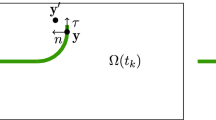Abstract
This article presents an evaluation of two different crack prediction approaches based on a comparison of the stress intensity factor distribution for three example problems. A single edge notch specimen and a quarter circular corner crack specimen subjected to shear displacements and a three point bend specimen with a crack inclined to the mid-plane are examined. The stress intensity factors are determined from the singular stress field close to the crack front. Two different fracture criteria are adopted for the calculation of an equivalent stress intensity factor and crack deflection angle. The stress intensity factor distributions for both numerical methods agree well to available reference solutions. Deviations are recorded at crack front locations near the free surface probably due to global contraction effects and the twisting behaviour of the crack front. Crack propagation calculations for the three point bending specimen give results that satisfy intuitive expectations. The outcome of the study encourages further pursuit of a crack propagation tool based on a combination of elements.
Similar content being viewed by others
References
BEASY (2007) BEASY V10r7 Documentation. C.M. BEASY Limited, 2007
Brebbia CA (1978) The boundary element method for engineers. Pentech Press, London
Bremberg D, Dhondt G (2008) Automatic crack-insertion for arbitrary crack growth. Eng Frac Mech 75: 404–416
Chanel B, Dhondt G (2007) Verallgemeinerung des MTU 3-D Rissfortschrittskriteriums auf anisotrope materialien, 39. Tagung DVM-Arbeitskreis Bruchvorgnge, Dresden, 13–14 Feb 2007
Cicilino AP, Aliabadi MH (1999) Three-dimensional boundary element analysis of fatigue crack growth in linear and non-linear fracture problems. Eng Frac Mech 63: 713–733
Citarella R, Buchholz FG (2008) Comparison of crack growth simulation by DBEM and FEM for SEN-specimens undergoing torsion or bending loading. Eng Frac Mech 72: 489–509
Dhondt G (1993) General behaviour of collapsed 8-node 2-D and 20-node 3-D isoparametric elements. Int J Num Meth Eng 36: 1223–1243
Dhondt G (1998) Automatic 3-D mode I crack propagation calculation with finite elements. Int J Num Meth Eng 41: 739–757
Dhondt G (1999) Automatic Three-dimensional cyclic crack propagation predictions with finite elements at the design stage of an aircraft engine. In: RTO AVT Symposium on design principles and methods for aircraft gas turbine engines. 11–15 May 1998. Toulouse, France, RTO MP-8, pp 33-1–33-8
Dhondt G (2005) Cyclic crack propagation at corners and holes. Fatigue Frac Eng Mater Struct 28: 25–30
Dhondt G, Chergui A, Buchholz FG (2001) Computational fracture analysis of different specimens regarding 3D and mode coupling effects. Eng Frac Mech 68: 383–401
Forman RG et al (1988) Development of the NASA/FLAGRO computer program. In: Read DT, Read RP (eds) Fracture mechanics: eighteenth symposium, ASTM STP 945. American society for testing and materials. Philadelphia, PA, pp 781–803
Mi Y, Aliabadi MH (1992) Dual boundary element method for three-dimensional fracture mechanics analysis. Eng anal Boundary Elem 1: 161–171
Murakami Y (ed) (1987) Stress intensity factors handbook. Pergamon Press, Oxford
NASCRAC (1989) Theory manual. Failure analysis associates. Palo Alto, CA
Paris PC, Erdogan F (1963) A critical analysis of crack propagation laws. J Basic Eng 85: 528–534
Paris PC, Gomez MP, Anderson WE (1961) A rational analytical theory of fatigue. Trend Eng 13: 9–14
Richard HA, Buchholz FG, Kullmer G, Schllmann M (2003) 2D- and 3D-mixed mode fracture criteria. Key Eng Mater 251–252: 251–260
Riddell WT, Ingraffea AR, Wawrzynek PA (1997) Experimental observations and numerical predictions of three-dimensional fatigue crack propagation. Eng Frac Mech 58: 293–310
Schöllmann M, Fulland M, Richard HA (2003) Development of a new software for adaptive crack growth simulations in 3D structures. Eng Frac Mech 70: 249–268
Schöberl J (1997) NETGEN—An advancing front 2D/3D-mesh generator based on abstract rules. Comp Vis Sci 1: 42–52
Timbrell C, Cook G (1997) 3-D FE fracture mechanics analysis for industrial applications. Zentech International Limited, UK. Seminar: “Inelastic finite element analysis", Institute of Mechanical Engineering, London, October 14, 1997
Wawrzynek PA, Martha LF and Ingraffea AR (1988) A computational environment for the simulation of fracture processes in three dimensions. In: Rosakis AJ et al (ed) Analytical, numerical and experimental aspects of three dimensional fracture processes. ASME AMD 91:321-327
Zienkiewicz OC (1971) The finite element method in engineering science. McGraw Hill, London
Author information
Authors and Affiliations
Corresponding author
Rights and permissions
About this article
Cite this article
Bremberg, D., Dhondt, G. Automatic 3-D crack propagation calculations: a pure hexahedral element approach versus a combined element approach. Int J Fract 157, 109–118 (2009). https://doi.org/10.1007/s10704-009-9313-z
Received:
Accepted:
Published:
Issue Date:
DOI: https://doi.org/10.1007/s10704-009-9313-z




